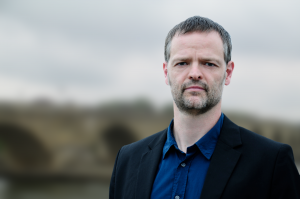Interview with PLOS ONE Academic Editor- Björn Brembs
As part of PLOS ONE’s 10th anniversary celebrations, for our latest interview with Editorial Board Members who have joined the journal when it was first launched, we met with neurobiologist Björn Brembs.
Björn Brembs is based a the University of Regensburg, Germany, where his group studies how brains generate spontaneous behavior, how they evaluate the sensory feedback from these actions and how different states of the animal influence the way these processes take place. He completed his PhD at the University of Würzburg, Germany and did a PostDoc in the Houston Health Science Center at the University of Texas, USA. Björn then spent a few years as an independent researcher at the Freie Universität in Berlin, Germany before becoming Adjunct Professor at the University of Leipzig. He finally joined the Institute of Zoology as a professor of neurogenetics of the University of Regensburg in 2012.
How did you first become interested in the neurobiology of behaviour?
I was inclined to study science in general and biology in particular already in my high-school years. After spending much of my youth outdoors observing all kinds of animals in the wild I started reading scientific books by all kinds of scientists. In the late eighties, nonlinear dynamics were very popular (at the time known as “chaos theory”), I learned about relativity, was fascinated by Quantum Mechanics, and read books by Konrad Lorenz on animal behavior, by Rupert Riedl on evolution and many other biologists. My compulsory one-year project was on the homing behavior in salmons.
So I was fascinated by big questions and thus broadly interested in the sciences, but the only area of biology I was sure I would never get into was neuroscience: I had read a book about the split-brain patients of Michael Gazzaniga’s, as well as Popper & Eccles’ book “the self and its brain”. I was captivated by the question of how our mind works, of whether we had free will and how we can know anything with any kind of certainty, but what I read in these books seemed so incomprehensibly complicated that I was sure it was way too complex for me.
During my first undergraduate semesters I became particularly interested in developmental biology: how could a largely uniform zygote bring about a highly differentiated adult individual? However, just about the time when I started to realize that I found the actual work in this field mind-numbingly boring (seemingly endless pipetting of clear liquids into other clear liquids and then waiting for hours for a machine to complete its job), I attended the Drosophila neurogenetics lecture by Martin Heisenberg (youngest son of Werner of uncertainty principle fame) and was hooked! I learned that in this field, not only could I study the questions Gazzaniga, Eccles, Popper, etc. had been writing about, but that Drosophila may constitute an experimental system which at least would only make me feel dumb, incompetent and insufficient some of the time and not all the time. During this time, I also worked on a few projects in population and behavioral ecology. These areas also involved a lot of time spent with animals and sometimes their behavior, but the ecological and evolutionary aspects again seemed highly interesting but much more complex and intractable than I thought my limited intellectual capacity allowed me to master.
I completed all Dr. Heisenberg’s department had to offer in terms of lectures and courses and I was even more thrilled by the work than initially. Eventually, Dr. Heisenberg became my thesis advisor and continues to be my mentor to this day. He became the first of three critical mentors who went above and beyond any ‘supervisor’ duties, supporting me at every step of the way. Without them I wouldn’t have stood a chance of survival in science. The research topic of the neurobiology of spontaneous behavior and how feedback modulates this spontaneity in operant learning situations fascinates me to this day.
What challenges and developments can we expect to see for this field in the next few years?
I’m a scientist and not a prophet, so I find it difficult to make predictions, in particular about the future.
In general I think we are in the middle of a genuine paradigm shift in the neurosciences that probably started sometime in the early nineties. Until then, large sections of neuroscience operated under the impression that neurons, circuits and indeed entire nervous systems operated like the machines we engineer: passively receiving some input and generating output. The early work of the ethologists in the mid-late 20th century as well as later neurophysiological evidence from mollusks and other accessible animals contradicted this concept, but had little effect on the larger community, despite the Nobel Prize for Lorenz and the other ethologists. My thesis advisor, Martin Heisenberg, also contributed many contradicting experiments and provided cogent and evidence-based arguments without much effect. It probably was the converging flood of evidence from a variety of disparate fields around the turn of the century, not the least the discovery of resting-state network in the human brain, that started shifting peoples’ attitudes. In addition to the work in humans, ethological work showed that the kind of reproducible behavior neuroscientists love to study in the lab carry the risk of being exploited in the wild, raising issues about how generalizable any knowledge from this kind of behaviors is to other behaviors. Many new preparations were developed where experimentally isolated nervous systems (‘brain in a vat’) generated organized, ethologically relevant spontaneous activity in the absence of any sensory organs. Evolutionary work seemed to suggest that the ancestral functional organization of nervous systems was to generate activity first and have sensory input modulate that activity later. Perhaps most amusingly, basic neuroscience research that had started in the 1980s suddenly became medically relevant and hence subject to much more attention. That work had accumulated evidence over about two decades that even spinal reflexes (e.g., knee-jerk reflex) are far from the input-output systems most textbooks portray them as.
All of this evidence, together with ever more refined imaging capabilities of nervous system activity across the field, has led to a much more refined, almost reversed conceptual framework in neuroscience: now, nervous systems are increasingly conceptualized as constantly active, incessantly varying this neural activity, with sensory stimuli exerting a modulating effect, the magnitude of which depends on the network state at which the stimulus arrives. As is so often the case in science, the most exciting new findings will probably come from experiments derived from this new perspective, experiments one could not have thought of from the old perspective.
You joined PLOS ONE‘s editorial board when the journal was launched 10 years ago. What attracted you to PLOS ONE in the first place?
At the time, access seemed like such a huge issue. I hadn’t realized, yet, what other, larger issues loomed behind those paywalls. PLOS in general and PLOS ONE in particular was a hip, new initiative. Supporting it helped me hit several birds with the same stone, two of which are: a) it enabled me to help push progress on publishing reform, both in terms of access and in terms of challenging journal rank. b) the work as an academic editor elevated my formal standing in the community and allowed me both to gather invaluable experience in the process of editing (crucial to the publication process) and to connect with colleagues in related fields I would otherwise not have been able to interact with.
The journal has grown beyond expectations. Why do you think a journal like PLOS ONE – a multidisciplinary and rigor-focused journal- is relevant to scientists in general and within your field in particular?
While there are now several of such journals, they help to continue demonstrating to authors and readers that the concept of thematically arranged journals is antiquated. In the digital age, we have much better ways of channeling relevant information to readers than pre-selected information silos that build walls, not bridges between the different research objects. “Megajournals” are not overloading us with irrelevant information, as we only see what is relevant – although much of the process remains to be optimized and more current technology needs to be leveraged in this regard. Only few of these journals, e.g. F1000 Research, are still pushing any boundaries. For most, this once innovative form of publishing seems to now have become a cash cow from which profits need to be milked, rather than sandboxes to be widened and expanded to eventually provide an actual library where all scholarly content can be found: narrative, data and code.
The publishing landscape has changed a lot in these 10 years. What do you think has been a positive change and where is there more work to do?
Actually, from my perspective, it has hardly changed:
- Publishing is still dominated by the main publishers which keep increasing their profit margins, sucking the public teat dry,
- Most of our work is still behind paywalls
- You won’t get a job unless you publish in high ranking journals.
- Higher ranking journals still publish less reliable science, contributing to potential replication issues
- The increase in number of journals is still exponential
- Libraries are still told by their faculty that subscriptions are important
- The digital functionality of our literature is still laughable
- There are no institutional solutions to sustainably archive and make accessible our narratives other than text, or our code or our data
The only difference in the last few years really lies in the fraction of available articles, but that still remains a small minority, less than 30% total.
So the work we need to do is the same as it was at the time the subversive proposal was written, 23 years ago: getting rid of paywalls. This goal won’t be reached until all institutions have stopped renewing their subscriptions. As I don’t know of a single institution without subscriptions, that task remains just as big now as it was 23 years ago. Noticeable progress has only been on the margins and potentially in people’s heads.
How do you see the future of publishing? Are there any initiatives that you find particularly exciting or promising?
Again, I’m not a prophet. If I had my way, I’d like to see institutions start dropping their subscriptions en masse and investing the money in a modern infrastructure, the sort of I have sketched out here.
I currently only see a few marginal initiatives or small groups of individuals starting to coalesce around this idea. Most larger or more well-known initiatives are still trying to care palliatively at for the symptoms, rather than attempting to cure the disease.
Featured image credit: From Flickr Creative Commons Photos. By Kristin Wolff under CC BY 2.0. Found here.

